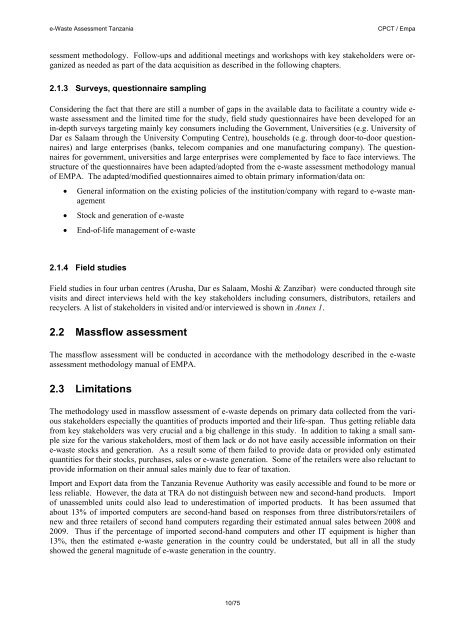e-Waste Assessment Tanzania - e-Waste. This guide
e-Waste Assessment Tanzania - e-Waste. This guide
e-Waste Assessment Tanzania - e-Waste. This guide
- No tags were found...
You also want an ePaper? Increase the reach of your titles
YUMPU automatically turns print PDFs into web optimized ePapers that Google loves.
e-<strong>Waste</strong> <strong>Assessment</strong> <strong>Tanzania</strong>CPCT / Empasessment methodology. Follow-ups and additional meetings and workshops with key stakeholders were organizedas needed as part of the data acquisition as described in the following chapters.2.1.3 Surveys, questionnaire samplingConsidering the fact that there are still a number of gaps in the available data to facilitate a country wide e-waste assessment and the limited time for the study, field study questionnaires have been developed for anin-depth surveys targeting mainly key consumers including the Government, Universities (e.g. University ofDar es Salaam through the University Computing Centre), households (e.g. through door-to-door questionnaires)and large enterprises (banks, telecom companies and one manufacturing company). The questionnairesfor government, universities and large enterprises were complemented by face to face interviews. Thestructure of the questionnaires have been adapted/adopted from the e-waste assessment methodology manualof EMPA. The adapted/modified questionnaires aimed to obtain primary information/data on:General information on the existing policies of the institution/company with regard to e-waste managementStock and generation of e-wasteEnd-of-life management of e-waste2.1.4 Field studiesField studies in four urban centres (Arusha, Dar es Salaam, Moshi & Zanzibar) were conducted through sitevisits and direct interviews held with the key stakeholders including consumers, distributors, retailers andrecyclers. A list of stakeholders in visited and/or interviewed is shown in Annex 1.2.2 Massflow assessmentThe massflow assessment will be conducted in accordance with the methodology described in the e-wasteassessment methodology manual of EMPA.2.3 LimitationsThe methodology used in massflow assessment of e-waste depends on primary data collected from the variousstakeholders especially the quantities of products imported and their life-span. Thus getting reliable datafrom key stakeholders was very crucial and a big challenge in this study. In addition to taking a small samplesize for the various stakeholders, most of them lack or do not have easily accessible information on theire-waste stocks and generation. As a result some of them failed to provide data or provided only estimatedquantities for their stocks, purchases, sales or e-waste generation. Some of the retailers were also reluctant toprovide information on their annual sales mainly due to fear of taxation.Import and Export data from the <strong>Tanzania</strong> Revenue Authority was easily accessible and found to be more orless reliable. However, the data at TRA do not distinguish between new and second-hand products. Importof unassembled units could also lead to underestimation of imported products. It has been assumed thatabout 13% of imported computers are second-hand based on responses from three distributors/retailers ofnew and three retailers of second hand computers regarding their estimated annual sales between 2008 and2009. Thus if the percentage of imported second-hand computers and other IT equipment is higher than13%, then the estimated e-waste generation in the country could be understated, but all in all the studyshowed the general magnitude of e-waste generation in the country.10/75
















